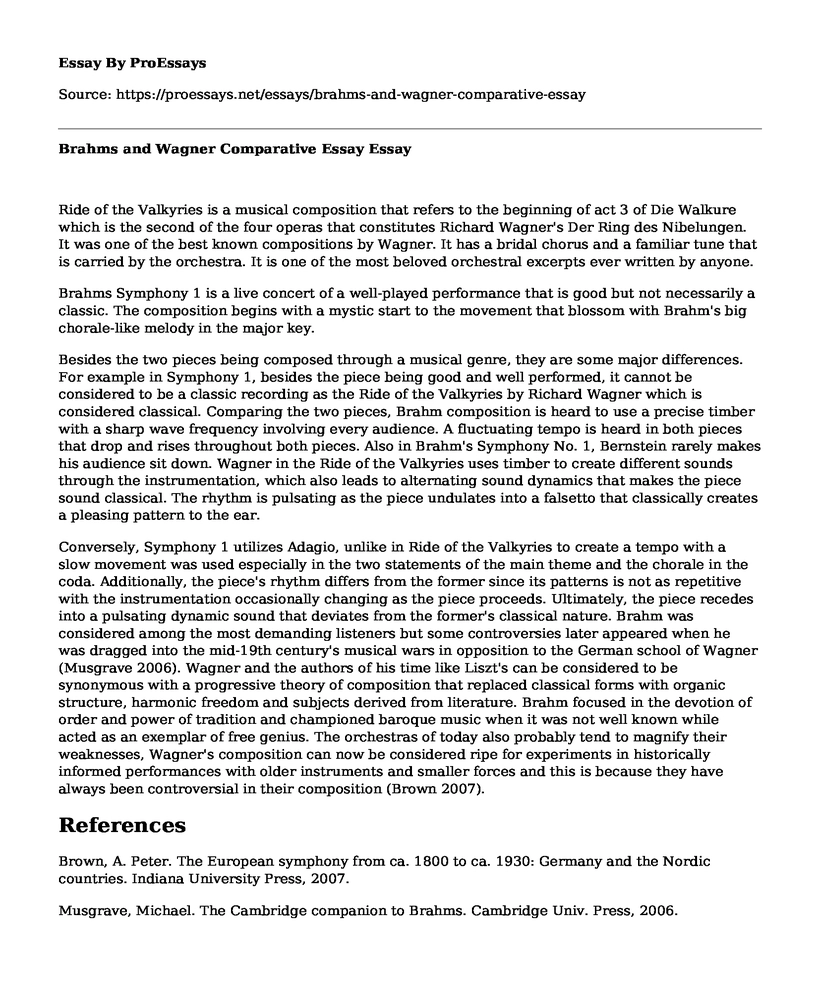Ride of the Valkyries is a musical composition that refers to the beginning of act 3 of Die Walkure which is the second of the four operas that constitutes Richard Wagner's Der Ring des Nibelungen. It was one of the best known compositions by Wagner. It has a bridal chorus and a familiar tune that is carried by the orchestra. It is one of the most beloved orchestral excerpts ever written by anyone.
Brahms Symphony 1 is a live concert of a well-played performance that is good but not necessarily a classic. The composition begins with a mystic start to the movement that blossom with Brahm's big chorale-like melody in the major key.
Besides the two pieces being composed through a musical genre, they are some major differences. For example in Symphony 1, besides the piece being good and well performed, it cannot be considered to be a classic recording as the Ride of the Valkyries by Richard Wagner which is considered classical. Comparing the two pieces, Brahm composition is heard to use a precise timber with a sharp wave frequency involving every audience. A fluctuating tempo is heard in both pieces that drop and rises throughout both pieces. Also in Brahm's Symphony No. 1, Bernstein rarely makes his audience sit down. Wagner in the Ride of the Valkyries uses timber to create different sounds through the instrumentation, which also leads to alternating sound dynamics that makes the piece sound classical. The rhythm is pulsating as the piece undulates into a falsetto that classically creates a pleasing pattern to the ear.
Conversely, Symphony 1 utilizes Adagio, unlike in Ride of the Valkyries to create a tempo with a slow movement was used especially in the two statements of the main theme and the chorale in the coda. Additionally, the piece's rhythm differs from the former since its patterns is not as repetitive with the instrumentation occasionally changing as the piece proceeds. Ultimately, the piece recedes into a pulsating dynamic sound that deviates from the former's classical nature. Brahm was considered among the most demanding listeners but some controversies later appeared when he was dragged into the mid-19th century's musical wars in opposition to the German school of Wagner (Musgrave 2006). Wagner and the authors of his time like Liszt's can be considered to be synonymous with a progressive theory of composition that replaced classical forms with organic structure, harmonic freedom and subjects derived from literature. Brahm focused in the devotion of order and power of tradition and championed baroque music when it was not well known while acted as an exemplar of free genius. The orchestras of today also probably tend to magnify their weaknesses, Wagner's composition can now be considered ripe for experiments in historically informed performances with older instruments and smaller forces and this is because they have always been controversial in their composition (Brown 2007).
References
Brown, A. Peter. The European symphony from ca. 1800 to ca. 1930: Germany and the Nordic countries. Indiana University Press, 2007.
Musgrave, Michael. The Cambridge companion to Brahms. Cambridge Univ. Press, 2006.
Cite this page
Brahms and Wagner Comparative Essay. (2022, Apr 04). Retrieved from https://proessays.net/essays/brahms-and-wagner-comparative-essay
If you are the original author of this essay and no longer wish to have it published on the ProEssays website, please click below to request its removal:
- Female in Art and Architecture - Essay Sample
- Research Paper on Theme of Post-Apocalyptic Anxieties in Residential Evil: Apocalypse
- The History and Classical Era of Piano Essay Example
- Essay on How Walt Disney Ruined Our Love Lives: The Impact on Modern Romantic Relationships
- Last Man Standing - Movie Analysis Essay
- 3 Varieties of News: Politics, Education, and Economy - Essay Sample
- Essay Example on Media Representation of Mental Illness: A 21st Century Challenge







